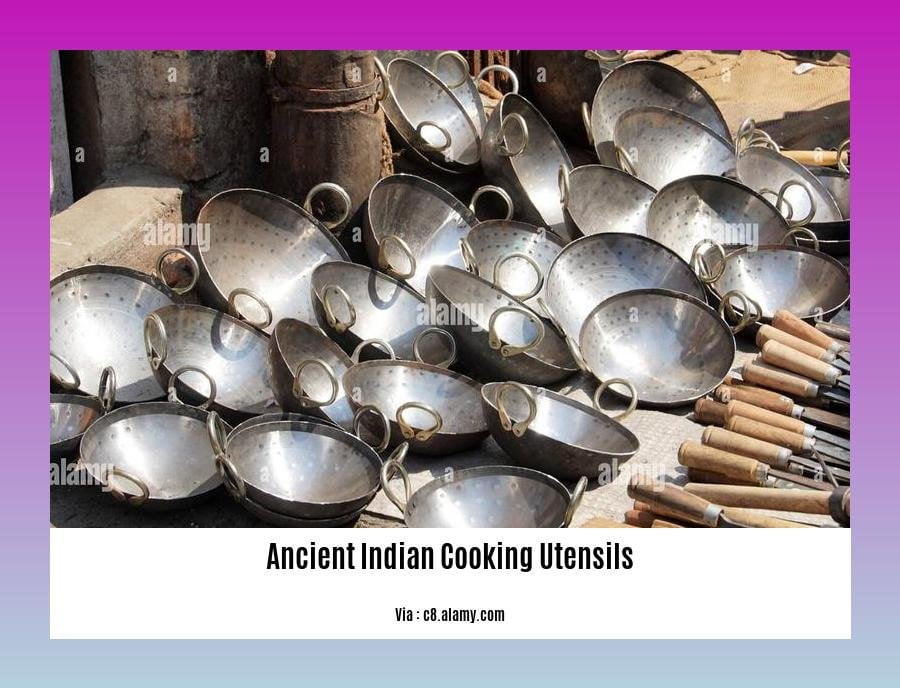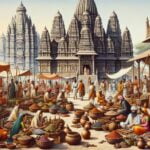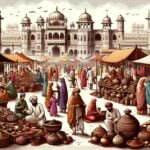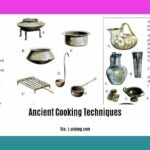Embark on a culinary journey through time as we delve into the captivating world of [The Culinary Crossroads: Exploring Ancient Indian Cooking Utensils]. From the bustling kitchens of ancient India, these enigmatic tools played a pivotal role in shaping the rich tapestry of Indian cuisine. Through archaeological discoveries and meticulous research, we’ll uncover the stories behind these utensils, their significance in shaping regional culinary traditions, and their enduring legacy on the global culinary landscape.
Key Takeaways:
Indian cuisine relies on a unique set of utensils that have evolved over centuries, enhancing the cooking experience and adding authenticity to dishes.
Essential Indian cooking utensils include the chimta (tongs), belan and chakla (rolling pin and flat board), jhaara (perforated ladle), kadai (deep-bottomed pan), tawa (griddle), pressure cooker, idli maker (steamer), masala daba (spice box), and spice grinder.
Traditional Indian cooking utensils are an integral part of the culinary culture, adding depth and authenticity to every dish.
These tools elevate the cooking experience and allow home cooks to create delicious, authentic Indian dishes.
Ancient Indian Cooking Utensils: A Culinary Journey Through Time
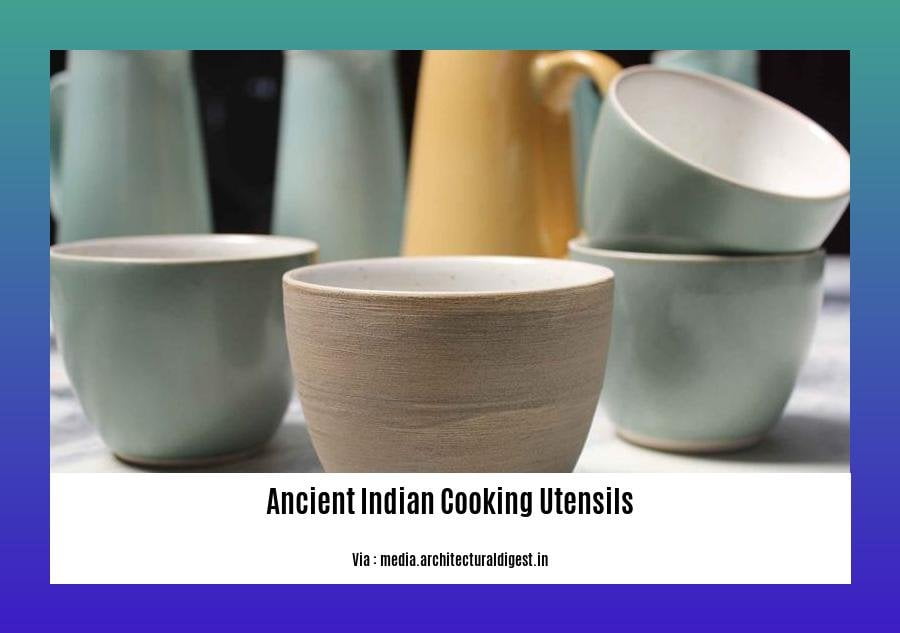
In the realm of culinary artistry, the history of ancient Indian cooking utensils unfolds a tale of innovation, tradition, and cultural exchange. These humble tools, crafted from diverse materials and imbued with centuries of wisdom, played a pivotal role in shaping the unique flavors and techniques that define Indian cuisine.
A Glimpse into India’s Culinary Heritage
The culinary landscape of India is a vibrant tapestry woven with regional and historical influences. From the bustling kitchens of the north to the aromatic flavors of the south, each region boasts its distinctive repertoire of dishes, each relying on a unique set of utensils.
Unveiling the Treasures of Ancient India’s Kitchens
A Culinary Symphony of Tools
The diversity of ancient Indian cooking utensils mirrors the richness of the cuisine itself. Each utensil, meticulously designed for a specific purpose, orchestrates a symphony of flavors and textures.
The Tawa: This flat, circular griddle is the heart of many Indian kitchens, used to create perfectly crisp dosas, golden-brown chapatis, and fluffy parathas.
The Kadhai: A versatile deep-bottomed pan, the kadhai is a culinary workhorse, perfect for stir-fries, curries, and deep-frying.
The Belan and Chakla: This duo, comprising a rolling pin and a flat board, is essential for preparing doughs and pastries, transforming them into thin, pliable sheets.
The Jhara: A perforated ladle or strainer, the jhara is used to drain excess oil from fried foods, ensuring a crispy, non-greasy texture.
The Idli Maker: This specialized steamer is used to create fluffy idlis, a popular South Indian breakfast dish, by steaming a batter made from rice and lentils.
Preserving Culinary Traditions: A Legacy of Taste
These ancient Indian cooking utensils are more than mere tools; they are cultural artifacts that embody the culinary traditions of India. Their use connects us to the past, preserving the heritage and authenticity of Indian cuisine.
In an era of rapid modernization, it is crucial to safeguard these culinary treasures, ensuring that future generations can continue to experience the joy of cooking with traditional ancient Indian cooking utensils.
Unlock the secrets of historical culinary arts with our ancient mead recipe, a mesmerizing blend of flavors that will transport you back in time.
Ancient Indian Cooking Utensils List
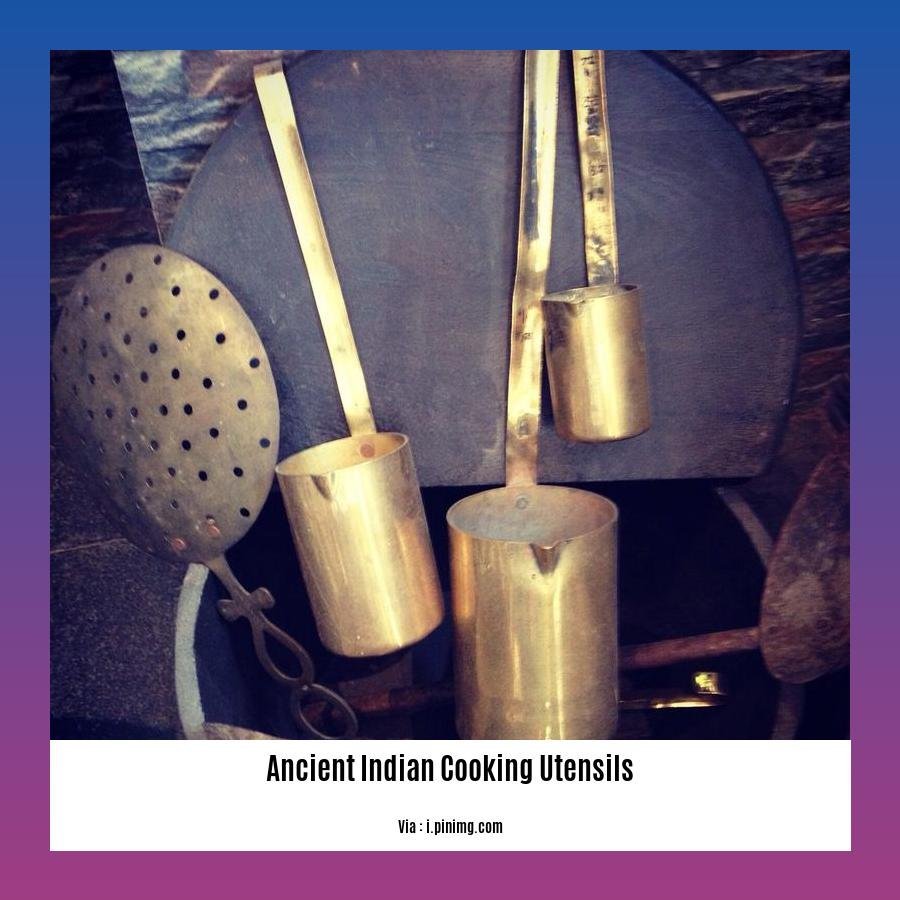
In the tapestry of culinary history, ancient Indian cooking utensils hold a significant place, bearing witness to the evolution of a rich and diverse cuisine. These tools, crafted from humble materials like clay, copper, and iron, tell stories of innovation, cultural exchange, and the ingenuity of our ancestors. Join us on a journey through time as we explore the ancient Indian cooking utensils that shaped this culinary heritage.
Introduction to Ancient Indian Cooking Utensils
Ancient Indian cooking utensils are a testament to the creativity and resourcefulness of our ancestors. These tools were designed to harness the power of fire, earth, water, and air to transform raw ingredients into delectable dishes. From the humble grinding stone to the elegant copper pots, each utensil played a vital role in shaping the flavors and textures that define Indian cuisine today.
Key Takeaways:
- Ancient Indian cooking utensils were crafted from locally available materials like clay, copper, and iron.
- These utensils served specific purposes, such as grinding, mixing, cooking, and storing food.
- The design of these utensils was influenced by factors like climate, geography, and cultural practices.
- Ancient Indian cooking utensils hold historical and cultural significance, reflecting the evolution of Indian cuisine.
- Preserving and promoting the use of these utensils can help keep culinary traditions alive.
Citation:
Types of Ancient Indian Cooking Utensils
The ancient Indian culinary landscape was adorned with a diverse array of cooking utensils, each serving a unique purpose. Let’s delve into some of the most iconic examples:
Grinding Stones: These rudimentary yet effective tools, often made from granite or sandstone, were used to grind grains, spices, and herbs into fine powders or pastes.
Mortar and Pestle: Another essential grinding tool, the mortar and pestle, was used to crush and mix ingredients, creating smooth pastes and flavorful spice blends.
Clay Pots: Clay pots, with their porous nature, imparted a distinct earthy flavor to food while allowing for even cooking and heat distribution.
Copper Vessels: Copper vessels, prized for their durability and heat conductivity, were used for various cooking techniques, including boiling, frying, and sautéing.
Iron Kadhai: The kadhai, a versatile iron wok, was used for deep-frying, stir-frying, and creating aromatic curries.
Spices Boxes: These intricately designed boxes, often made of wood or metal, were used to store and organize the vast array of spices that are integral to Indian cuisine.
Cultural Significance of Ancient Indian Cooking Utensils
Ancient Indian cooking utensils were not merely functional tools; they held deep cultural significance and were often associated with traditions and beliefs. For instance, clay pots were believed to purify food and water, while copper vessels were considered auspicious and used in religious ceremonies. These utensils were also intricately linked to regional cuisines, reflecting the diverse culinary traditions across India.
Conclusion
Ancient Indian cooking utensils stand as a testament to the ingenuity and creativity of our ancestors. These tools, crafted from humble materials, played a pivotal role in shaping the rich tapestry of Indian cuisine. Today, they continue to be used in homes and restaurants, serving as a tangible link to our culinary heritage. Preserving and promoting these utensils is not just about safeguarding a culinary legacy; it’s about keeping alive the stories, traditions, and flavors that have been passed down for generations.
Citation:
- Ancient Indian Utensils
Traditional Indian Cooking Utensils: Tools That Tell a Story
There’s a dance in every kitchen, a rhythm in every dish. The sizzle of spices, the gurgle of simmering sauces, the clang of metal against metal. In the kitchens of India, these sounds are orchestrated by a symphony of traditional utensils, each one a relic of history, a reflection of culture, and a testament to the artistry of Indian cuisine.
A Culinary Canvas
Indian cooking is a tapestry of flavors, a vibrant symphony of spices and textures. The traditional utensils used in this cuisine are not just tools; they are an extension of the cook’s hands, shaping and molding the ingredients into culinary masterpieces.
The tava, a flat griddle, is a versatile performer, capable of creating the perfect dosa, the crispy paratha, and the fluffy pancake. The kadhai, a deep-bottomed pot, is the trusty sidekick for curries, biryanis, and stir-fries. The sil batta, a stone grinder, patiently releases the aromatic oils from spices, creating pastes that form the heart of many Indian dishes.
A Window to the Past
These utensils are not just kitchenware; they carry stories of the past, tales of tradition, and the evolution of Indian cuisine. The earthenware pots, for instance, have been used for centuries to store water and buttermilk, their porous nature keeping the contents cool and fresh. The brass vessels, once considered auspicious, were used in religious ceremonies and for everyday cooking.
The pestle and mortar, a timeless tool, has graced kitchens for millennia, its rhythmic pounding creating spice blends that are both flavorful and aromatic. The rolling pin and chakla, used for rolling out dough, represent the meticulousness and patience that go into Indian cooking.
A Legacy to Preserve
These traditional utensils are not just relics of the past; they are living traditions, passed down from generation to generation, connecting us to our culinary heritage. Preserving and promoting their use is not just about keeping history alive; it’s about safeguarding the identity and authenticity of Indian cuisine.
Key Takeaways:
- Traditional Indian cooking utensils are an integral part of the country’s culinary heritage.
- These utensils are not just tools; they are an extension of the cook’s hands and an expression of creativity.
- The utensils range from the versatile tava to the deep-bottomed kadhai to the stone grinder sil batta.
- These utensils carry stories of the past, reflecting tradition and the evolution of Indian cuisine.
- Preserving and promoting the use of traditional Indian cooking utensils is essential for safeguarding the identity and authenticity of Indian cuisine.
Sources:
- Traditional Utensils and Cookware in Indian Cooking
- Indian Cooking Utensils: A Guide to the Essential Tools
FAQ
Q1: What materials were commonly used to make ancient Indian cooking utensils?
A1: Ancient Indian cooking utensils were often crafted from materials such as clay, copper, brass, iron, and stone. Each material imparted unique properties to the cooking process, influencing the flavor and texture of the dishes. For instance, clay pots provided even heat distribution, while copper and brass utensils enhanced the taste of food.
Q2: Can you name some iconic ancient Indian cooking utensils and briefly describe their uses?
A2: Sure. Some iconic ancient Indian cooking utensils include:
Mortar and Pestle (Khal Dasta): Used for grinding spices, herbs, and other ingredients to create smooth pastes and chutneys.
Churner (Mathni): A long, hand-held device used to churn lentil soup or curds into lassi, a refreshing yogurt-based drink.
Earthen Pot (Matka): A traditional pot made of clay, used for storing water and buttermilk. It helps keep the contents cool and fresh.
Cooking Pot (Handa): A metal pot with a narrow neck and wide base, commonly used to make traditional Indian dishes like biryani.
Q3: How did ancient Indian cooking utensils contribute to the unique flavors and aromas of Indian cuisine?
A3: Ancient Indian cooking utensils played a significant role in shaping the distinct flavors and aromas of Indian cuisine. The use of specific metals like copper and brass enhanced the taste of food by reacting with the ingredients and releasing trace minerals. Additionally, the design of utensils like tandoors and clay ovens allowed for unique cooking methods that imparted smoky and earthy flavors to dishes.
Q4: Are there any ancient Indian cooking utensils that are still in use today?
A4: Yes, many ancient Indian cooking utensils have stood the test of time and are still widely used in traditional Indian kitchens. Examples include the mortar and pestle (sil batta), the rice strainer (soru vadi thattu), and the churner (mathni). These utensils are valued for their durability, functionality, and the unique culinary experience they provide.
Q5: How can I incorporate ancient Indian cooking utensils into my modern kitchen?
A5: Incorporating ancient Indian cooking utensils into a modern kitchen can add a touch of authenticity and cultural heritage to your cooking. Some versatile utensils that can easily be integrated include the mortar and pestle for grinding spices, the earthen pot (matka) for storing water or yogurt, and the tawa (flat griddle) for making flatbreads and pancakes. Experimenting with these utensils can enrich your culinary repertoire and introduce new flavors and textures to your dishes.
- SYBAU See You Baby Meaning: Gen Z Slang Evolves - July 1, 2025
- Unlock Your Inner Youth: Lifestyle Secrets for a Vibrant Life - July 1, 2025
- Decode SYBAU Meaning: Gen Z Slang Explained - July 1, 2025
